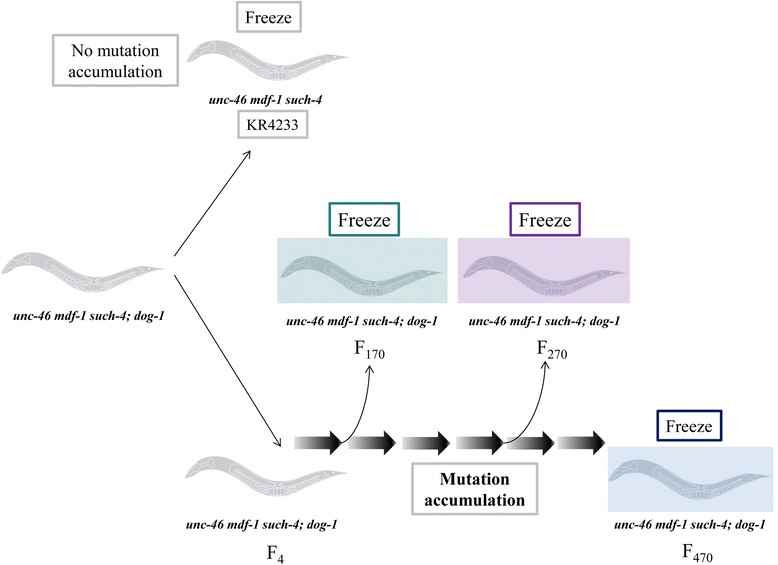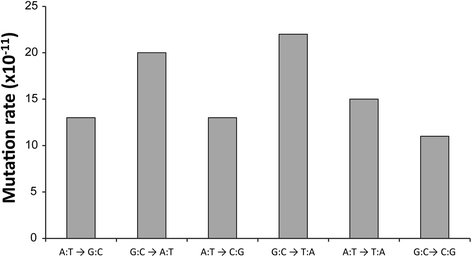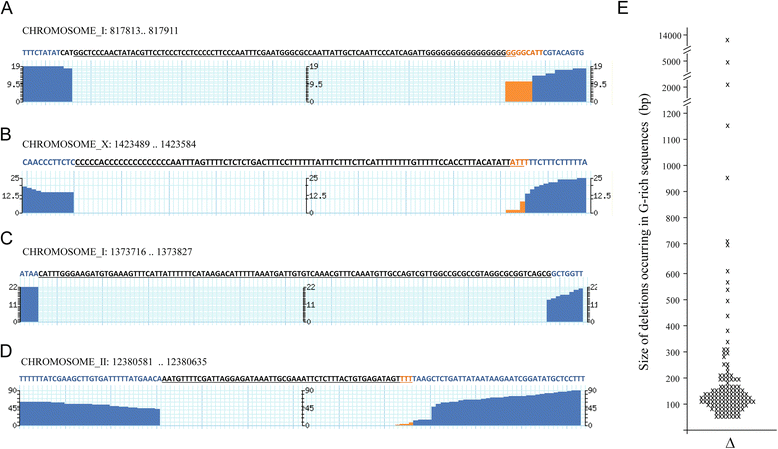Spectrum of variations in dog-1/FANCJ and mdf-1/MAD1 defective Caenorhabditis elegans strains after long-term propagation
- PMID: 25880765
- PMCID: PMC4369104
- DOI: 10.1186/s12864-015-1402-y
Spectrum of variations in dog-1/FANCJ and mdf-1/MAD1 defective Caenorhabditis elegans strains after long-term propagation
Abstract
Background: Whole and partial chromosome losses or gains and structural chromosome changes are hallmarks of human tumors. Guanine-rich DNA, which has a potential to form a G-quadruplex (G4) structure, is particularly vulnerable to changes. In Caenorhabditis elegans, faithful transmission of G-rich DNA is ensured by the DOG-1/FANCJ deadbox helicase.
Results: To identify a spectrum of mutations, after long-term propagation, we combined whole genome sequencing (WGS) and oligonucleotide array Comparative Genomic Hybridization (oaCGH) analysis of a C. elegans strain that was propagated, in the absence of DOG-1 and MDF-1/MAD1, for a total of 470 generations, with samples taken for long term storage (by freezing) in generations 170 and 270. We compared the genomes of F170 and F470 strains and identified 94 substitutions, 17 InDels, 3 duplications, and 139 deletions larger than 20 bp. These homozygous variants were predicted to impact 101 protein-coding genes. Phenotypic analysis of this strain revealed remarkable fitness recovery indicating that mutations, which have accumulated in the strain, are not only tolerated but also cooperate to achieve long-term population survival in the absence of DOG-1 and MDF-1. Furthermore, deletions larger than 20 bp were the only variants that frequently occurred in G-rich DNA. We showed that 126 of the possible 954 predicted monoG/C tracts, larger than 14 bp, were deleted in unc-46 mdf-1 such-4; dog-1 F470 (JNC170).
Conclusions: Here, we identified variants that accumulated in C. elegans' genome after long-term propagation in the absence of DOG-1 and MDF-1. We showed that DNA sequences, with G4-forming potential, are vulnerable to deletion-formation in this genetic background.
Figures



Similar articles
-
Cyclin B3 and dynein heavy chain cooperate to increase fitness in the absence of mdf-1/MAD1 in Caenorhabditis elegans.Cell Cycle. 2014;13(19):3089-199. doi: 10.4161/15384101.2014.949491. Cell Cycle. 2014. PMID: 25486568 Free PMC article.
-
Mutagenic capacity of endogenous G4 DNA underlies genome instability in FANCJ-defective C. elegans.Curr Biol. 2008 Jun 24;18(12):900-5. doi: 10.1016/j.cub.2008.05.013. Epub 2008 Jun 5. Curr Biol. 2008. PMID: 18538569
-
Spectrum of mutational events in the absence of DOG-1/FANCJ in Caenorhabditis elegans.DNA Repair (Amst). 2008 Nov 1;7(11):1846-54. doi: 10.1016/j.dnarep.2008.07.011. Epub 2008 Aug 30. DNA Repair (Amst). 2008. PMID: 18708164
-
Genetic instability of C. elegans comes naturally.Trends Genet. 2005 Feb;21(2):67-70. doi: 10.1016/j.tig.2004.11.015. Trends Genet. 2005. PMID: 15661349 Review.
-
Comparative genomics in C. elegans, C. briggsae, and other Caenorhabditis species.Methods Mol Biol. 2006;351:13-29. doi: 10.1385/1-59745-151-7:13. Methods Mol Biol. 2006. PMID: 16988423 Review.
Cited by
-
Protection of the C. elegans germ cell genome depends on diverse DNA repair pathways during normal proliferation.PLoS One. 2021 Apr 27;16(4):e0250291. doi: 10.1371/journal.pone.0250291. eCollection 2021. PLoS One. 2021. PMID: 33905417 Free PMC article.
-
FANCJ at the FORK.Mutat Res. 2016 Jun;788:7-11. doi: 10.1016/j.mrfmmm.2016.02.003. Epub 2016 Feb 17. Mutat Res. 2016. PMID: 26926912 Free PMC article. Review. No abstract available.
-
Variation in G-quadruplex sequence and topology differentially impacts human DNA polymerase fidelity.DNA Repair (Amst). 2022 Nov;119:103402. doi: 10.1016/j.dnarep.2022.103402. Epub 2022 Sep 9. DNA Repair (Amst). 2022. PMID: 36116264 Free PMC article.
-
Single variant, yet "double trouble": TSC and KBG syndrome because of a large de novo inversion.Life Sci Alliance. 2024 Jan 22;7(4):e202302115. doi: 10.26508/lsa.202302115. Print 2024 Apr. Life Sci Alliance. 2024. PMID: 38253421 Free PMC article.
-
Getting Ready for the Dance: FANCJ Irons Out DNA Wrinkles.Genes (Basel). 2016 Jul 1;7(7):31. doi: 10.3390/genes7070031. Genes (Basel). 2016. PMID: 27376332 Free PMC article. Review.
References
-
- Cheung I, Schertzer M, Rose A, Lansdorp PM. Disruption of dog-1 in Caenorhabditis elegans triggers deletions upstream of guanine-rich DNA. Nat Genet. 2002;31:405–9. - PubMed
Publication types
MeSH terms
Substances
Grants and funding
LinkOut - more resources
Full Text Sources
Other Literature Sources
Research Materials
Miscellaneous

